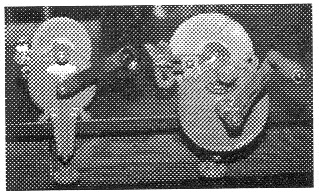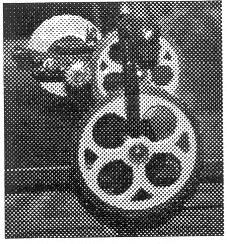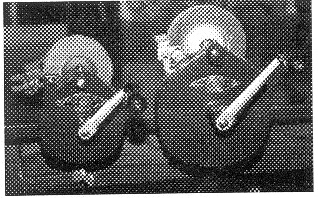
by PAST Member Tom Thornton
(Webmaster's note: This article was scanned from the Summer 1998 issue of ToolTalk.)
The Collection
I have been collecting hand cranked grinders for about 3 years and now have 24 in my collection. I began when I needed a simple and fast way to remove plastic from a model Motor driven tools worked too quickly which resulted in the model burning and melting.
I realized that a handcrank stone would be able to move slow enough to permit controlled cutting but I soon found out that they have been extinct since 1955.
Because they were often used in dirty, oily, and gritty conditions, hand cranked grinders are usually found at flea markets looking like old blobs of grease with the crank and wheel the only visible means of recognition. They range in price from $2.00 - $25.00 depending on how dirty or clean they are. The best cleaning method is a wire brush. The wheel can be soaked for several days in any standard household cleaner. I really enjoy restoring the grinders from a grease ball to a working tool.
Some grinders are marked with the manufacturer's name cast into the body while others only have a decal that gives no indication of the maker. I prefer to collect those With makers names.
The Grind Stone Wheel
Before the 1800s, the grind stone, or piece of natural stone formed into a wheel. was found to be too full of impurities and of random grit to be of value in commercial use.
About 1860, the Industrial Revolution created the need for a consistent abrasive wheel to be used for shaping and finishing steels used in the manufacture of the sewing machine and firearms.
The first manufacturers crushed natural emery and corundum, washed out the impurities. passed it through sieves to grade it, mixed it with potters clay. and formed it into wheels that were baked in potters' kilns. Pike of New Hampshire, and Norton of Massachusetts (both were pottery manufacturers) were the first companies to make them.
My collection of wheels ranges from the simple formed emery wheel to the corundum grits to the new vitrified wheels that are made today making a great deal of variety in my collection of hand grinders.
Which Direction?
When sharpening, should the abrasive contact the cutting edge first (push edge into stone) or should the cutting edge be drawn away from the stone (pull edge from stone)? It depends on your preference. If you draw the cutting edge from the stone, it tends to make a wire edge that will have to be stropped off, but some insist this is the best edge for many types of cutting. If you don't need or want the wire edge, then you push the cutting edge into the stone. The person sharpening with a oval pattern (back and forth) on a flat stone mayor may not need to strop. Some hand grinders are equipped with two tool rests so the work edge may be fed in either direction.
The hand cranked grinder has always been a utility tool used mainly to
sharpen other tools. With the availability of cheap electric motors after 1945,
the electric bench grinder eliminated the market for this manual tool.

Modern Grinder Co.
Sheboygan, WI
These two grinders are of completely different construction, but have an
identically round fluted nut on the bench clamp screw.

The manufacturer of this grinder is unknown. It has dual exposed gearing; the gearing (1 x 22) permits speeds of over 2,000 RPM with average cranking.

Carborundum (now part of Norton) was at one time a watchword for grinding.
Both grinders have dustless oil caps on both shafts & very ornate ID tags.